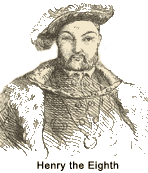By 1500, England was arguably the most politically advanced nation in Europe. It had been engaged in a centuries-long struggle between the monarchy and nobility that predated the famed Magna Charta (1215). Ever-increasing restraints were being placed on royal authority by an influential representative assembly, the Parliament, but its true flowering still lay in the future. Also noteworthy was the English system of justice, which relied heavily on common law precedents rather than the king's dictates.
Despite these political advances, England had experienced a tumultuous recent past. The Hundred Years War with France (1337-1453) was both expensive and divisive. Natural disaster in the form of the Black Death (1348) took a tremendous toll and helped to weaken the feudal system, that ancient form of social organization in England.
Economic change also helped to form the emerging nation. During the 1300s, a thriving wool industry developed. Early merchants exported raw wool to European markets; later, mills were built in England, which fostered a much more profitable trade in woolen cloth. This economic growth came at a high cost to many in society, however. As the demand for grazing lands grew, landlords evicted many resident agricultural workers. During the late 1400s, crisis conditions persisted. A dwindling food supply was called upon to feed a rapidly expanding population. The result was widespread social unrest as well as sickness and starvation.
The House of Tudor
The Tudor line of monarchs provided some the most remarkable leaders in English history, but their era was one of great turbulence. Foreign rivalries, dynastic succession and religious allegiances all played prominent roles.
Henry VII, the first Tudor king (ruled 1485-1509), brought a large measure of stability to English society. He bequeathed to his son relative political peace and a full treasury.
Henry VIII (r. 1509-47) did not squander his inheritance. Under his leadership, England grew more prosperous through trade and became a full partner in Renaissance learning then sweeping much of Western Europe. Henry's major problem was one of succession. He was married to Catherine of Aragon, the aunt of the powerful Holy Roman Emperor Charles V (simultaneously Charles I of Spain). The queen was approaching the end of her child-bearing years and had produced a daughter, but no male heir. Henry feared the implications of entrusting England's future to a woman and sought an annulment of his marriage from the Bishop of Rome. The pope refused, citing lack of grounds, but his decision also reflected the reality that Charles carried more weight internationally than Henry.
 Anxious to wed the comely Anne Boleyn, Henry secured passage of the Act of Supremacy (1534) by Parliament. This measure ended papal authority in England and made the king head of the church in England. Most of the bishops supported the annulment and remarriage. Henry's power was further bolstered when he seized church property within his realm. The monks and nuns were turned out and the monasteries sold to wealthy nobles. In this way, Henry increased his treasury and formed a firm bond with grateful nobles.
Anxious to wed the comely Anne Boleyn, Henry secured passage of the Act of Supremacy (1534) by Parliament. This measure ended papal authority in England and made the king head of the church in England. Most of the bishops supported the annulment and remarriage. Henry's power was further bolstered when he seized church property within his realm. The monks and nuns were turned out and the monasteries sold to wealthy nobles. In this way, Henry increased his treasury and formed a firm bond with grateful nobles.
During the remainder of Henry's reign, the church in England remained largely untouched by the Reformation, except for the obvious lack of ties with Rome. For a number of years following Henry's death, England would be led along alternating religious paths. During the short and unhappy reign of Edward VI (r. 1547-53), the English church veered toward Calvinism. However, under Mary I (r. 1553-58) a concerted effort was made to reestablish ties with Rome. Protestants were ruthlessly persecuted, which earned the queen the epithet "Bloody Mary." Many religious dissidents fled during these years, including a contingent that settled in Geneva. Those refugees came under the influence of the area's stern Calvinism and would later return to England where they became known as the Puritans.
Elizabeth I (r. 1558-1603) was the most successful of the Tudor monarchs. She followed a middle course on religious matters by resisting the extremes of both the Catholics and the Calvinists. The Elizabethan Age saw the flowering of literature, most notably through the works of William Shakespeare, and a corresponding development in commercial activity.
One mark of Elizabeth's canniness was her ability to hold off the attentions of Philip II of Spain. He had proposed marriage in order to expand his realm of influence and win back wayward England to Catholicism. Elizabeth had no desire to lead her country down that path and managed to delay a final answer for years. She knew that a confrontation with Spain would occur at some point, but wanted to wait until English defenses were strengthened.
Tensions with Spain were brought to the boiling point by the Sea Dogs, a group of privateers who preyed on the riches found in Spanish ships coming from the New World. Elizabeth provided unofficial encouragement for these ventures, which were headed by the likes of Francis Drake, John Hawkins, Walter Raleigh and Humphrey Gilbert.
Philip's patience was eventually exhausted. He realized that Elizabeth would never marry him and that the maritime rivalry between the two nations probably was sanctioned by the queen. Spain's response came in the form of an attempted invasion of England, conducted by the Spanish Armada (1588). Its utter and famous defeat left England unchallenged as the major sea power in the world.
Early Exploration and Colonization
England's early endeavors in the Western Hemisphere trailed those of Spain and France, but included the following major ventures: